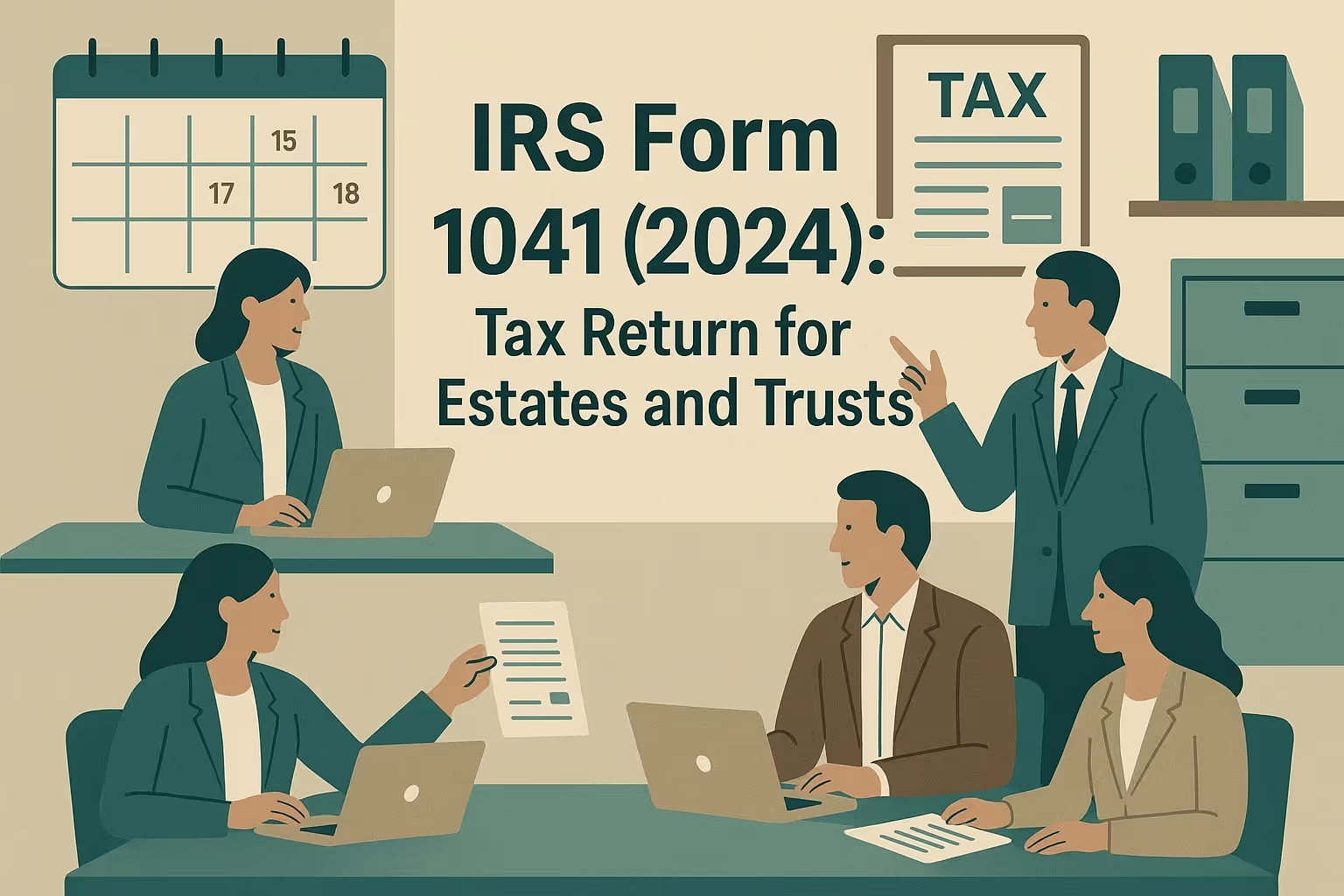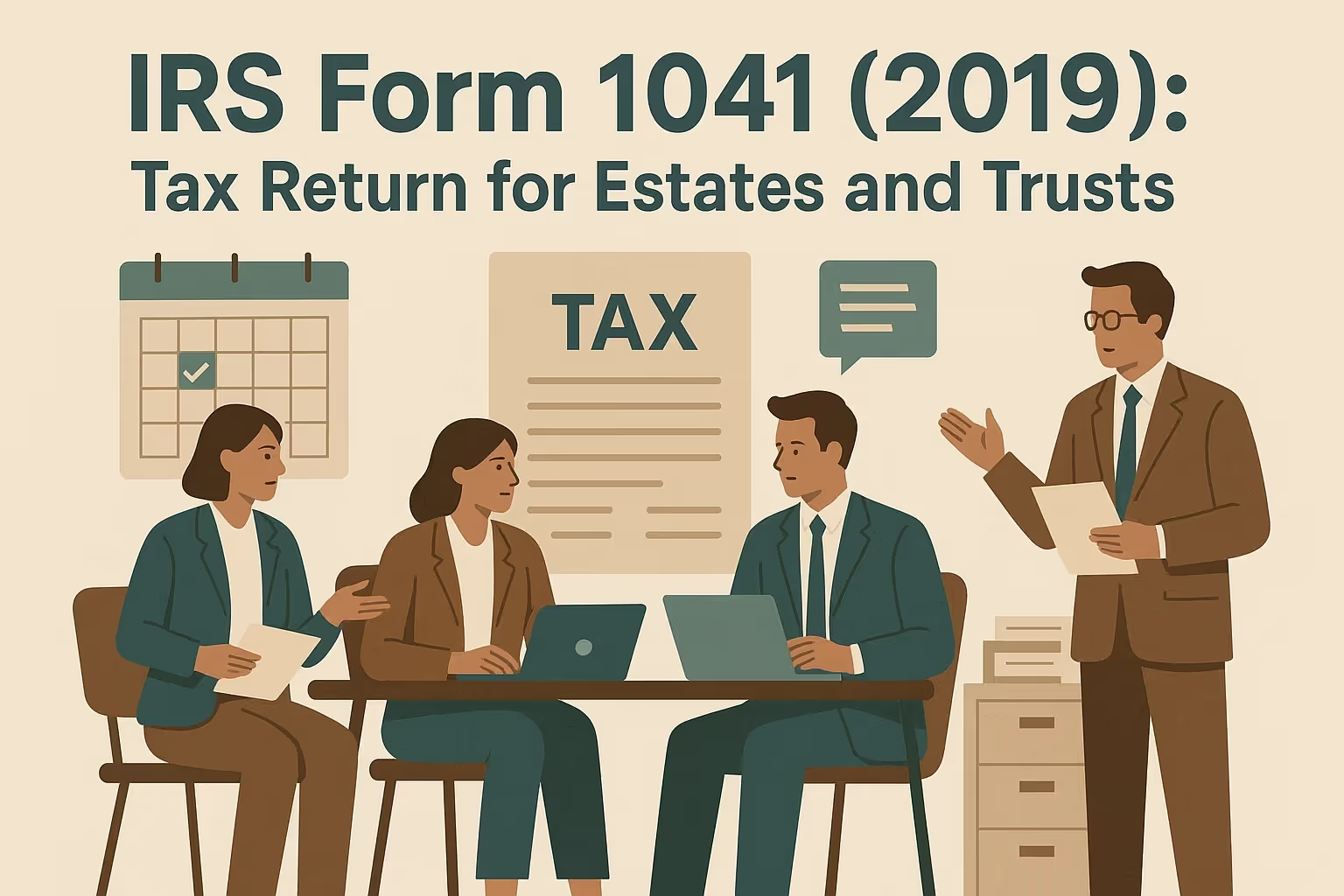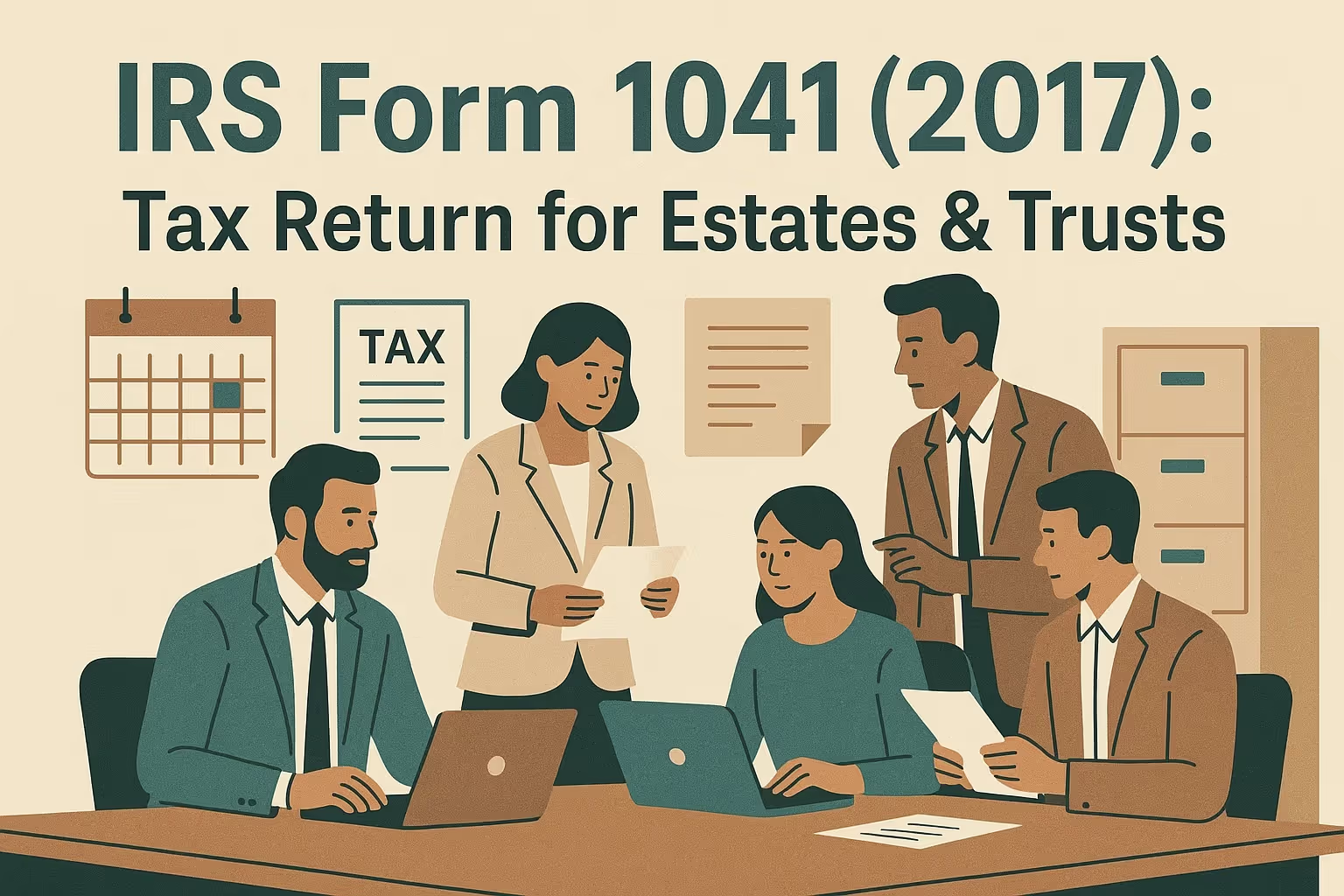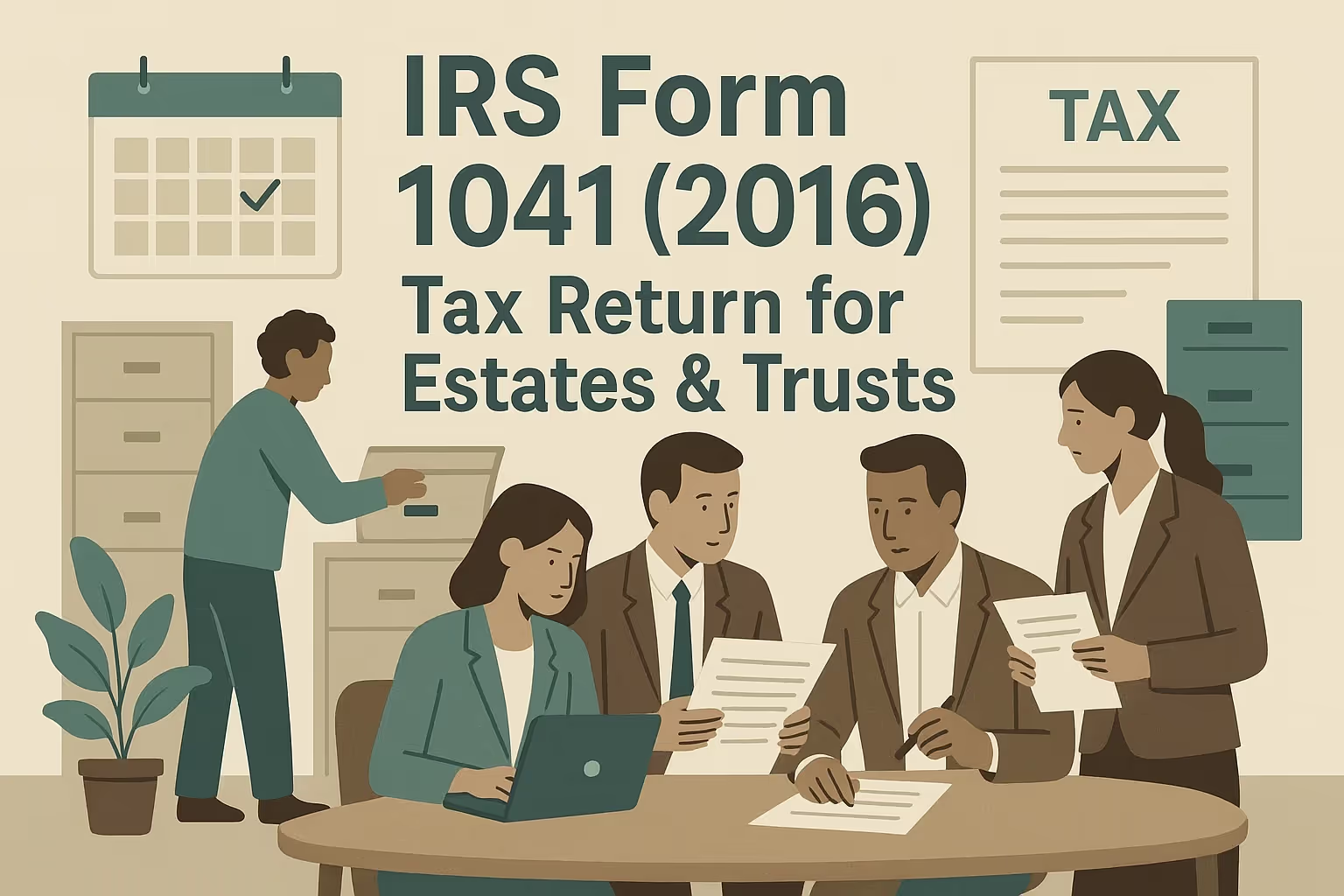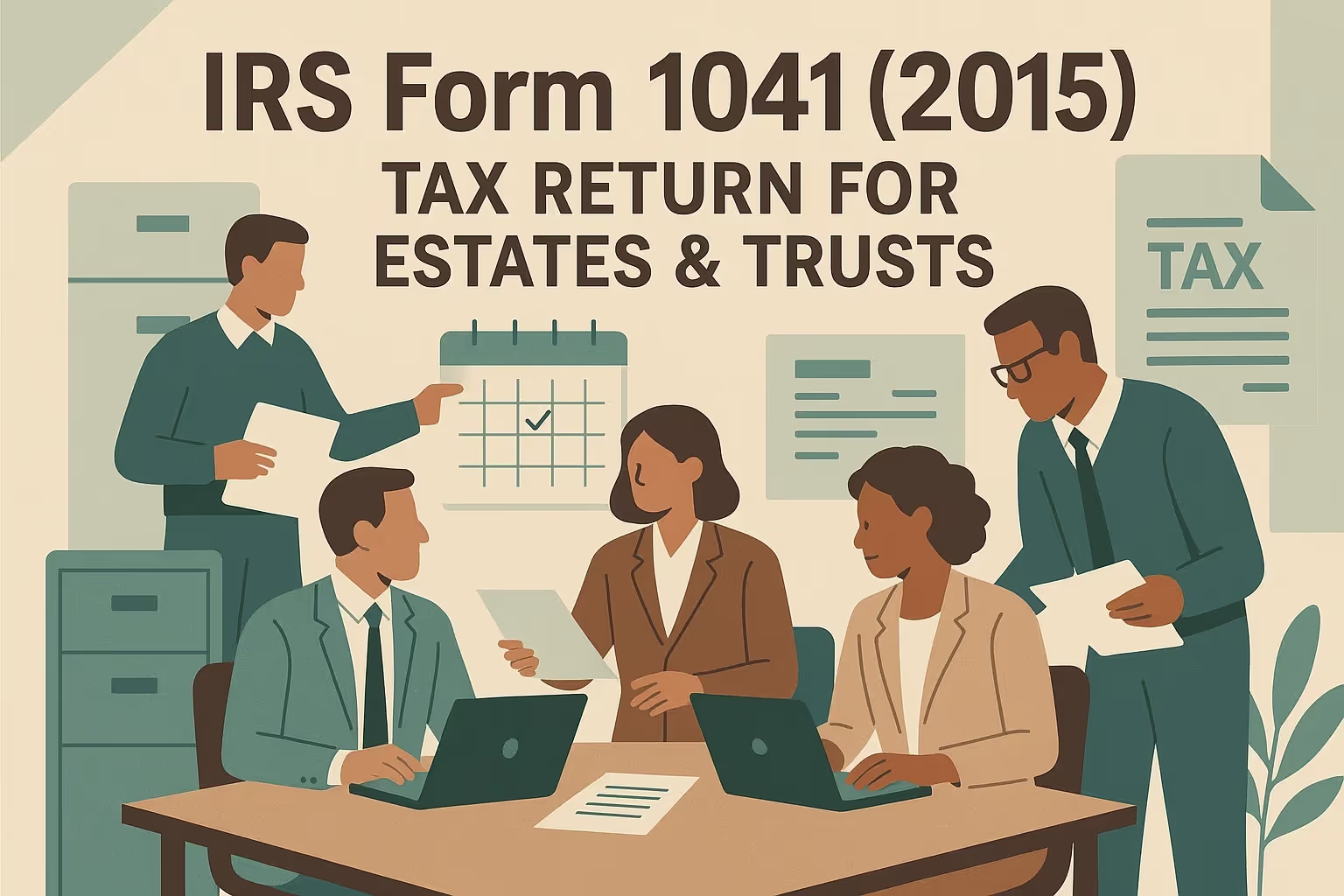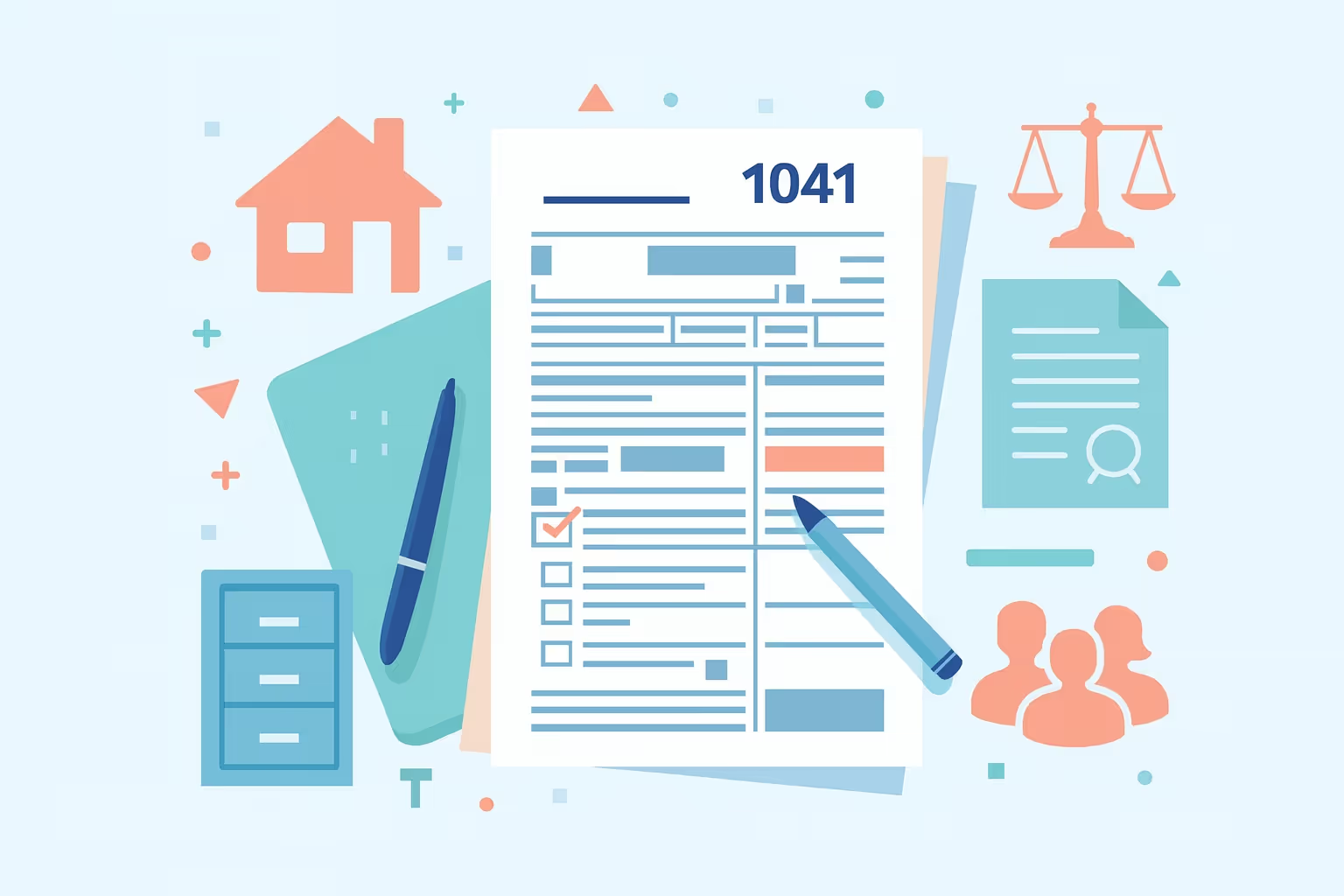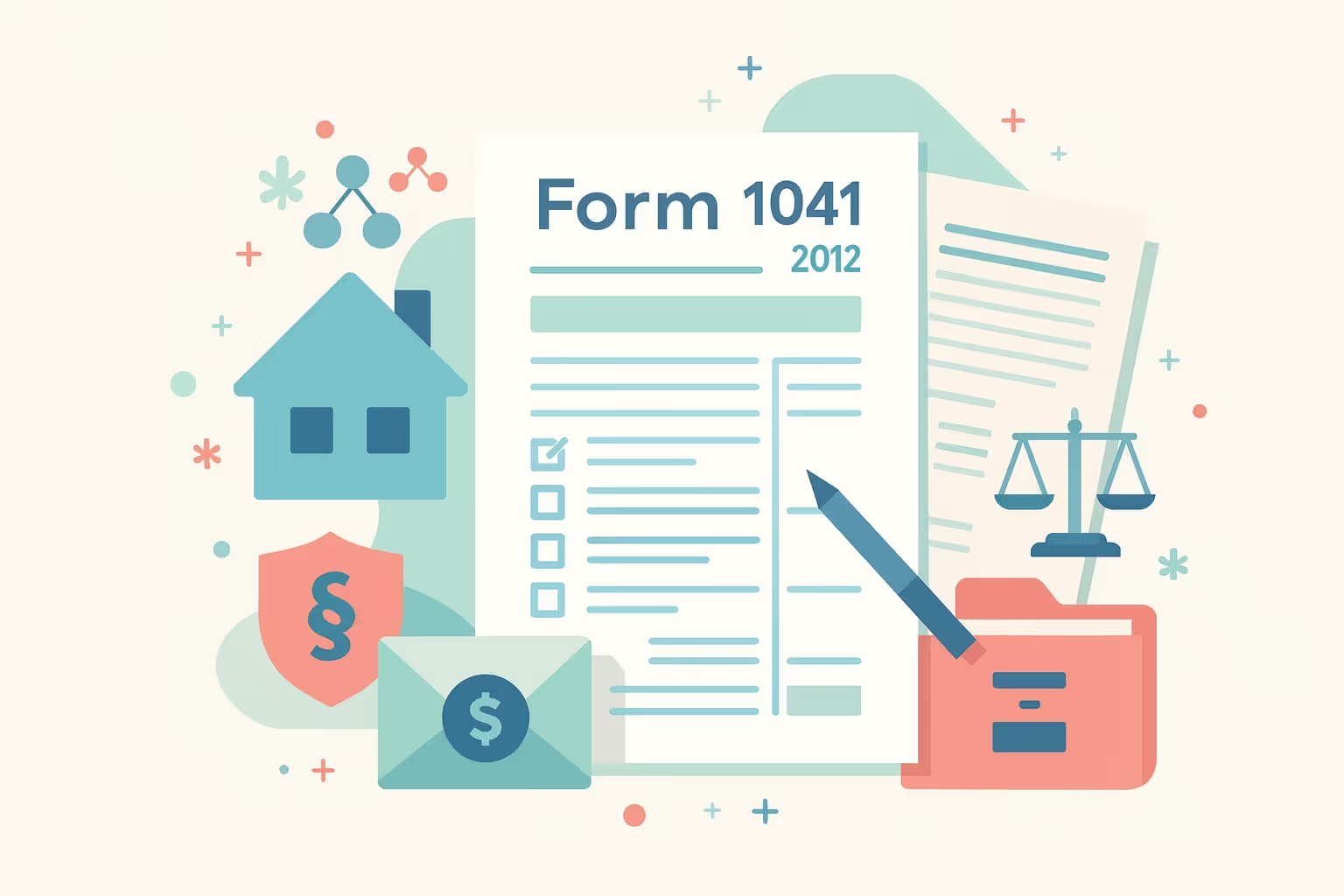How to File Federal Form 1041 for Tax Year 2023
Every year, fiduciaries file thousands of estate and trust returns—many get it wrong. The IRS reports that math errors, missing Schedules K-1, and late filings are among the top causes of refund delays. For estates and trusts, this can mean frustrated beneficiaries, interest charges on unpaid tax, and unnecessary correspondence with the Internal Revenue Service. If you are responsible for filing this fiduciary income tax return, understanding the rules for federal Form 1041 for tax year 2023 is not optional; it is essential.
Filing accurately is more than a compliance obligation—it is also a safeguard against financial loss. Missing the April 15, 2024, deadline (April 17 if you are in Maine or Massachusetts) can result in a failure-to-file penalty of 5 percent per month, up to 25 percent of the unpaid balance. Simple oversights like forgetting to claim the income distribution deduction or misreporting dividend income can shift taxable income back to the estate or trust and increase the overall tax owed. These errors can also create complications when beneficiaries prepare their personal income tax returns.
This guide will walk you through everything you need to know about Form 1041, from determining who must file to reporting income earned and paying tax correctly. Whether handling a decedent’s estate, a simple or a complex trust, this resource will show you how to avoid costly mistakes and file confidently.
What It Is and When It Applies
Before entering numbers or preparing schedules, confirm whether filing Form 1041 is required for your estate or trust. Filing when you do not need to wastes time; failing to file when required can lead to penalties and interest charges.
Definition and Purpose
- Form 1041 is the U.S. fiduciary income tax return used by estates and trusts to report income, deductions, tax credits, and income distributed to beneficiaries. It bridges the entity’s financial activity with the IRS, ensuring the correct income tax liability is calculated.
- This return also provides beneficiaries with an official record of their share of income via Schedule K-1. Beneficiaries then use this to complete their personal income tax return and pay tax on their portion of revenue.
Who Must File and Key Thresholds
- A decedent’s estate must file if it has $600 or more in gross income for the year or has a nonresident alien beneficiary. This rule applies even if the estate is opened shortly after the decedent’s death.
- A domestic trust must file if it has any taxable income, $600 or more in gross income, or any nonresident alien beneficiaries. Bankruptcy estates must file once income exceeds $13,850 for the tax year 2023.
- Filing Trigger: $600+ gross income or any nonresident alien beneficiary
- Notes: Includes interest, dividends, rental real estate
- Examples: Estate of John Smith, Deceased
- Filing Trigger: Any taxable income or $600+ gross income
- Notes: Applies to simple, complex, and irrevocable trusts
- Examples: Family living trust with rental income
- Filing Trigger: $13,850+ gross income
- Notes: Treated as a separate taxable entity
- Examples: Chapter 7 or Chapter 11 case
What Changed This Year
With your filing requirement confirmed, the next step is understanding the 2023 updates that could affect taxable income and refund timing. These changes impact everything from capital gains rates to how you submit supporting documents to the IRS.
Capital Gains and Qualified Dividends
- Estates and trusts hit higher capital gains tax brackets much sooner than individuals. For tax year 2023, the 20 percent maximum rate applies when income exceeds $14,650. Failing to plan for this can result in unexpectedly high income tax liability.
- Consider timing distributions to align with distributable net income. This may pass some capital gains through to beneficiaries, potentially lowering the tax paid at the estate or trust level.
- Income Level: $0 to $3,050
- Income Level: $3,051 to $14,650
- Income Level: Above $14,650
Exemptions and E-file Improvements
- Exemptions remain $600 for estates, $300 for simple trusts, $100 for complex trusts, and $4,700 for qualified disability trusts. These amounts reduce the total income before tax is calculated.
- The e-file now supports amended returns and allows you to attach all supporting documents as PDFs. This eliminates the need to mail separate attachments and speeds up refund processing compared to paper filing.
Pre-Filing Checklist and Setup
Before entering any numbers on Form 1041, prepare your documentation and confirm the entity’s tax identifiers. This step reduces errors and prevents last-minute delays that can lead to penalties or missed deadlines.
Identification and Governing Documents
- Before filing, obtain an employer identification number (EIN) for the estate or trust. The estate executor or trustee should never use a Social Security number, as doing so can cause the return to be rejected.
- Keep the will, trust document, or court order close at hand. You will need it to verify how income should be classified and whether distributions are required during the tax year.
Data and Beneficiaries
- Gather all tax documents, including Forms 1099 for interest, dividend income, and mutual funds. Confirm that all savings and brokerage accounts have been reviewed for income earned during the tax year.
- Collect names, addresses, and taxpayer identification numbers for all beneficiaries. If a beneficiary is a nonresident alien, special reporting requirements apply and must be addressed before the return is filed.
- Compile expense records for deductible interest, taxes, attorney, and fiduciary fees. These deductions will directly lower taxable income and should be fully documented.
Completing these setup steps ensures you have the information needed to accurately report income categories and apply the income distribution deduction when appropriate.
Step-by-Step Filing Guide
With your documents and EIN ready, you can complete Form 1041 in a structured order. This process minimizes errors and helps ensure the Internal Revenue Service accepts the return promptly.
Page 1 Entity Information
- Begin by entering the complete legal name of the estate or trust, mailing address, and the date it was created or the decedent’s death date. This establishes the tax year and entity identity.
- Provide the employer identification number in the correct box. Confirm that you are checking the right entity type, such as decedent’s estate, simple trust, complex trust, grantor trust, or bankruptcy estate, since this drives tax calculations.
Reporting Income Categories
- Report income earned during the tax year, including interest, dividends, ordinary business income, rental real estate, and capital gains. Use Schedules C, D, E, F, or Form 4797 to provide detail.
- Verify that income totals match the figures reported on 1099s and brokerage statements. Accurate reporting supports the beneficiary’s share on Schedule K-1 and avoids IRS correspondence.
Deductions and Distribution Deduction
- List deductible items such as fiduciary fees, attorney fees, deductible interest, property taxes, and charitable contributions. Attach supporting statements where required by the Internal Revenue Code.
- Use Schedule B to compute the income distribution deduction. This reduces the estate or trust's taxable income and shifts the obligation to beneficiaries, who report it on their personal income tax returns.
Exemption Amount and Taxable Income
- Apply the correct exemption based on whether you are filing for an estate, simple, complex, or qualified disability trust. This amount is subtracted from adjusted total income.
- Confirm that any estate tax return interactions are handled correctly, including deductions for income in respect of a decedent, such as a final paycheck. Errors here can lead to double taxation.
Schedule G Tax Computation and Payments
- Use Schedule G to compute total income tax owed, including alternative minimum tax and net investment income tax if applicable. Claim any tax credits available to the estate or trust to reduce liability.
- The report estimated tax payments and withholding amounts made annually for tax payment purposes. Compare these payments to the total income tax liability to determine whether a balance is due or a refund is expected.
Schedule K-1 Preparation and Delivery
- Prepare a Schedule K-1 for each beneficiary. Show income categories, credits, and the effect of the income distribution deduction so the beneficiary can accurately complete their return.
- Deliver K-1s to beneficiaries by the same date the Form 1041 is filed. Missing or late K-1s often result in amended personal returns and penalties, so prioritize timely distribution.
These steps ensure that total income, deductions, and distributions are correctly reported. Once the main form and schedules are complete, review the return thoroughly before signing and submitting it.
Required Schedules and When To Use Them
Once you complete the main form, attach the correct schedules to provide supporting detail. Each schedule specifically calculates taxable income and determines how much tax is passed to beneficiaries.
Core Schedules
- Schedule A: Use this when the estate or trust makes charitable contributions. It allows you to deduct cash or property contributions to qualified organizations, subject to the rules of the Internal Revenue Code.
- Schedule B: It calculates the income distribution deduction and distributable net income. The result is critical because it sets the maximum income that can be shifted from the estate or trust to beneficiaries for tax purposes.
Transactions and Special Computations
- Schedule D: Report capital gains and losses from sales of property, mutual funds, or other capital assets. Keep short-term and long-term gains separate because they are taxed at different rates.
- Schedule G: This schedule finalizes the income tax computation, accounts for tax credits, and reports any payments made. Schedule J is used only for complex trust accumulation distributions that require a throwback calculation.
- Required Schedule/Form: Schedule A
- Why It Applies: Allows deduction of qualified gifts
- Notes: Attach receipts or fair market value statements
- Required Schedule/Form: Schedule B
- Why It Applies: Computes income distribution deduction and DNI
- Notes: Impacts Schedule K-1 totals
- Required Schedule/Form: Schedule D
- Why It Applies: Separates long-term and short-term capital gains
- Notes: Include mutual fund capital gain distributions
- Required Schedule/Form: Schedule G
- Why It Applies: Summarizes tax owed and payments
- Notes: Attach proof of estimated payments
- Required Schedule/Form: Schedule J
- Why It Applies: Handles complex trust throwback tax rules
- Notes: Rare, but must be completed if triggered
Special Situations and Practical Examples
Understanding unique scenarios can help avoid common mistakes when estates and trusts have complex structures or unusual transactions.
Decedent’s Estate, Simple Trust, Complex Trust
- A decedent’s estate may elect a fiscal year rather than a calendar year on its first return. This can spread income over multiple beneficiary years and create planning opportunities.
- A simple trust must currently distribute all income, whereas a complex trust can accumulate or distribute principal. This difference affects taxable income and whether an income distribution deduction applies.
Grantor Trusts, Foreign Trust, Two or More Trusts
- Grantor trusts generally report all income directly on the grantor’s personal return. However, the fiduciary may still file an informational Form 1041 to report that the trust is treated as a grantor trust.
- Foreign trusts and situations involving two or more trusts require extra care. Coordinating filings prevents duplication and ensures compliance with the Internal Revenue Code.
Rental Real Estate, Dividends, and IRD Items
- If the estate or trust owns rented property, report rental real estate income and related expenses such as taxes, interest, and repairs. Depreciation schedules must be maintained for accuracy.
- Dividend income, interest, and income for a decedent, such as a final paycheck, must be appropriately allocated. Misclassifying these items can inflate taxable income or distort the beneficiary’s share.
- Who Files: Executor, trustee, or personal representative
- Purpose: Reports estate or trust income, deductions, and distributions
- Timing: 15th day of the fourth month after the tax year ends
- Who Files: Individual taxpayer
- Purpose: Reports wages, personal income, and credits
- Timing: April 15 (or next business day)
Payments, Estimates, Credits, and Refund Timing
After calculating taxable income, the next step is determining how much tax must be paid and how to handle refunds. This section ensures you stay compliant and avoid penalties.
Estimated Taxes and Safe Harbor
- If the estate or trust expects to owe $1,000 or more in tax for the year, quarterly estimated payments are required using Form 1041-ES. Payments are due in April, June, September, and January.
- Following the safe harbor rules helps avoid failure-to-pay penalties. Ensure your estimated payments equal at least 90 percent of the current year’s tax liability or 100 percent of the prior year’s tax liability.
Payment Options and Refund Timelines
- Electronic payment options include Direct Pay, EFTPS, or electronic funds withdrawal when e-filing. These methods are secure and provide immediate confirmation for tax payment purposes.
- If you expect a refund, filing electronically is the fastest way to receive it. E-filed returns are generally processed within 2–3 weeks, while the painfully slow paper process can delay refunds for 6–8 weeks or longer.
- When mailing a payment, use Form 1041-V and include the EIN and tax year on the check’s memo line. This ensures proper credit to the estate or trust’s account.
Careful payment planning prevents interest charges and keeps the estate or trust in good standing with the Internal Revenue Service.
Common Errors and How To Avoid Them
Filing Form 1041 involves multiple steps and schedules, which leaves room for avoidable mistakes. Catching these issues early can save time, money, and unnecessary IRS correspondence.
Identification and Classification
- Using a Social Security number instead of an employer identification number is a frequent error. Always apply for an EIN before filing and verify it is correctly entered on the form.
- Selecting the wrong entity type on Page 1 leads to incorrect tax calculations. Review the trust document or court order to confirm whether you are filing for a simple trust, complex trust, or decedent’s estate.
Reporting and Assembly
- Misallocating income between the fiduciary entity and beneficiaries can inflate taxable income or understate the beneficiary’s share. Use Schedule B to align distributions with distributable net income.
- It is a common mistake to claim nondeductible funeral expenses, medical expenses, or beneficiaries' personal expenses. Only deductible expenses allowed under the Internal Revenue Code should be included.
- Assemble the return in the order the IRS requires: main form first, schedules alphabetically, forms numerically, and other statements last. Missing signatures or incorrect dates can cause the return to be considered incomplete.
Avoiding these errors helps ensure timely processing, accurate tax liability, and fewer notices from the IRS.
Zero-Activity Years, Fiscal Year Elections, and Final Return
Not every estate or trust has significant yearly income; some eventually terminate. Knowing when a return is still required—or when to file a final return—is key to staying compliant.
Dormant or Low-Activity Periods
- If gross income is under $600 and there are no nonresident alien beneficiaries, filing Form 1041 is generally not required. However, maintain records of bank interest and other income sources to prove that you met the threshold requirements.
- Monitor accounts annually and check whether income in the new tax year exceeds $600 before the due date. Overlooking a threshold breach can result in late filing penalties.
Fiscal Year vs. Calendar Year; Final Return
- Estates may elect a fiscal year on their first Form 1041 filing. This option can spread income across multiple beneficiary years, helping manage tax liabilities. Trust tax year rules are stricter and typically require calendar year reporting.
- When an estate or trust administration ends, mark the return as “final.” Distribute all remaining assets and issue final Schedule K-1s to beneficiaries, ensuring the beneficiary’s share is correctly reported.
Timely final returns prevent open-year issues and close the fiduciary’s responsibilities with the Internal Revenue Service.
E-File vs Paper Filing Logistics
Choosing the correct filing method can affect how quickly the IRS processes your fiduciary income tax return and issues any refund.
Steps and Pros or Cons
- E-file: Submitting electronically is strongly recommended. It allows you to attach supporting documents as PDFs, generates faster acknowledgments, and reduces the chance of math errors. E-filed returns typically result in refunds within two to three weeks.
- Paper Filing: While still allowed, mailing the return can be painfully slow. Paper returns often take six to eight weeks to process and carry a higher risk of delays if assembled incorrectly. If you must file by paper, follow the IRS assembly order carefully and use tracking when mailing.
Electronic filing is the faster, safer choice for most fiduciaries.
FAQs
Who must file Form 1041, and how do gross income thresholds work?
You must file Form 1041 if the estate or trust has $600 or more in gross income, any taxable income, or a nonresident alien beneficiary. Bankruptcy estates must file once gross income reaches $13,850. These thresholds apply even if income comes only from savings accounts, rental real estate, or mutual funds. Filing ensures proper tax reporting under the Internal Revenue Code.
What income categories are reported, and how does the income distribution deduction apply?
Report interest, dividend income, ordinary business income, rental real estate, capital gains, and other income categories. After deducting expenses, use Schedule B to calculate the income distribution deduction. This deduction shifts taxable income to beneficiaries based on distributable net income. It ensures beneficiaries report their correct share on their personal income tax return, preventing overpayment at the estate or trust level.
How do capital gains and dividends affect taxable income for estates and trusts?
Capital gains and qualified dividends are taxed using a compressed bracket structure. For tax year 2023, the 20 percent capital gains rate applies once income exceeds $14,650. Some trust documents allow capital gains to be distributed to beneficiaries, which may reduce total income taxed at the entity level. Always review governing documents to confirm whether gains are retained or passed through.
What is the difference between a fiduciary income tax return and a personal income tax return?
A fiduciary income tax return (Form 1041) reports income earned by an estate or trust and calculates the entity’s income tax liability. A personal income tax return (Form 1040) reports wages, interest, and income distributed to beneficiaries. The fiduciary return determines the beneficiary’s share and issues Schedule K-1 so that individuals can accurately report the income on their personal return.
When is the final return filing due, and how do Schedule K-1 and beneficiary’s share rules apply?
A final return is filed when all assets have been distributed and the estate or trust is closing. Mark the “Final Return” box on Form 1041, report all income through the termination date, and prepare final Schedule K-1s for each beneficiary. The K-1s show the beneficiary’s share of income and deductions for their personal income tax reporting obligations.






